Dimming Radiance: Poems and Prose Parables
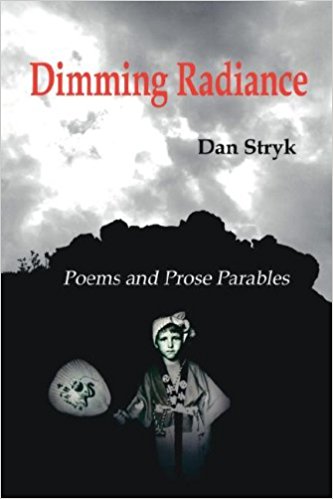
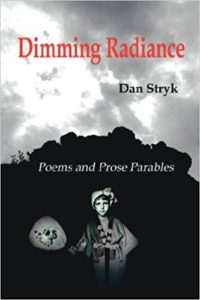
Dimming Radiance: Poems and Prose Parables,
by Dan Stryk, Wind Publications, Nicholasville, KY, 2008,
149 pages, paper, $15.00, ISBN: 978-1-893239-66-1
In a present where we are deluged with images, a world of visual and auditory white noise, where speed is of the essence and attention may only focus for a millisecond, a book like Dan Stryk’s Dimming Radiance serves as a resting place, a water lily pad on which we can slow ourselves and look carefully at the life we inhabit. Dan’s poems and parables gently demand attention to the moment we find ourselves in. As in the poem “On Viewing a Scroll by I Fu-Chiu,” where the last lines remind us softly:
An eddy
seeps from rippled pole,
surrounds us . . .
All haste,
past and future,
seems a loss. (17)
A lover of the diversity in the world and widely-traveled, Dan Stryk brings to his work influences from Japan, the Blue Ridge Mountains, France, Italy, Iran, and the shores of the muddied ponds of the Midwest. He places them in chalices of parables, tanka, brief eggshells of poems, and wide webs of spun stories. He believes that “form is strongly influenced by content,” much as Robert Creeley approached his poems, Dan feels that “form and content must find balance.” The small poem, “Snow,” unfolded before me as I sat writing this during the blizzard of a few nights ago:
Wound-covering,
the snow fell full
that day. Blending
the evening’s scattered
view, the cars
hulking our tired
street, in still
white mounds, soft-
edged. Strange
how the greatest
pain is gently shaped
by wisdom . . . (76)
I was suspended somewhere between the swirling white outside and the soft mounds of my own dreaming. It seems to me that this is what good poems do. They take us simultaneously deeper into ourselves and urge us to surrender to the whole world outside ourselves. The drifts outside my window were echoing in the drifting of the poem’s form, its regular waves.
Having read this collection, I was moved to call Dan at his home and thank him for the respite and comfort I found within these pages. What could have been a simple thanks to a fellow poet I had never met became a two and a half hour conversation about our lives, our work, and the need to stay in touch with the natural world as a source of who we are and why we write. It was clear that Dan felt great reverence and admiration for the poems of his father, Lucien, and his great friend and mentor, William Heyen. At the same time he is deeply involved with finding ways to build gates and bridges to all he observes and becomes. The poems, “Master Heron” and “Waterbird in Winter” offer a glimpse into his approach. In the first, he observes; in the latter, he is. From “Master Heron”: . . . Your samurai beak, / time after time, piercing / the ocean’s heart. (8) to the poem, “Waterbird in Winter,” where he writes . . . and then I hear / a message / murmuring through / the narrows / of my flute–like skull / as I stoop / to the small hole.” (9) To see these poems on facing pages is to take the journey with Dan from seeing to being. The epigraph fronting this poem is from a T’ang axiom: “Look as, not at, the heron to arouse the river’s spirit.”
The different forms in Dan’s poems take us from the bird-skeletal delicacy of the shorter poems to the shambling bear parables that turn the world into teaching moments. The parables are a delicious mix of used tires, world literature, jazz and country, philosophy and soggy sneakers. It is a rare gift to combine the horseshoe games of neighbors from the local meat packing plant with the Zen mindfulness of surrendering to the sunset, but Stryk calls on these varied sources to place himself and his reader in both places, trying to balance his quest for the stillness of inner peace with his need to hear “Nice one, Hun!” as he flings a dreamed-of ringer at dusk, something of clouds and iron.
This collection, as variable as it is in approach to form, holds together beautifully as a document of the continuing search of Dan Stryk to achieve balance, to be the human seeker as well as the heron he observes, peering ever deeper into the pool of the world.
I’ll leave you with a bit of “Crows in Grey Mist,”
And now — my engine softening its roar on downslope
in the valley toward Boone — I think of how we’re drawn so
deeply to the momentary. Inks pooled rich, or soft, or too
thin to observe, but felt, in flux of clarity and haze, like sud-
den flight. Things we can’t own, or love, too long . . . (20)
This review serves as only the first sip of a comforting tea, the warmth of a questioning flame at the heart’s hearth. The steam is rising now.
— Michael Macklin
To and From
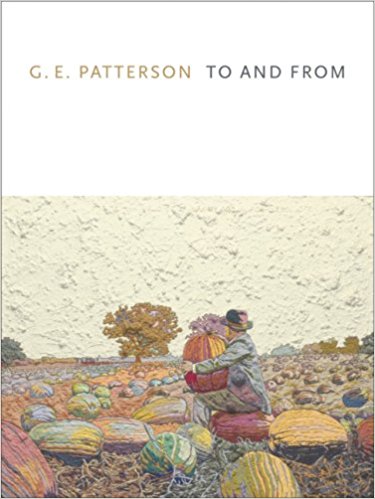
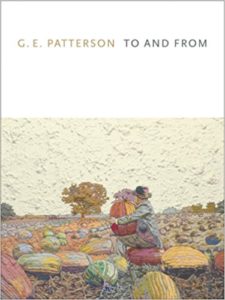 To and From,
To and From,
by G. E. Patterson, Ahsahta Press, 2008,
74 pages, paper, $17.50,
ISBN: 978-0-916272-99-9
Sometimes a book surprises you before you even start reading. That’s what happened to me when I first opened G. E. Patterson’s To and From. When I turned to the first poem and saw the epigraph “ . . . you?” (1) left-justified, followed by “ . . . and touch . . . ” (1) right-justified in the white space above the title, I was a little taken aback before I even got to the poem itself. I flipped through the book and saw that every poem had a splatter of quotations hanging above, and often below, the title. Even stranger than the placement was the nature of the quotes; these were not your usual epigrams, but fragments made up of workaday words. I was suspicious. This looked a lot like experiment for experiment’s sake; a writer concerned more with impressive flourishes than actual good writing. I was very, very wrong.
As it turns out these strange epigraphs aren’t fluff at all, but something of a thought cloud that the poems seep out of, and which hangs around the poems like mist. They set the tone for each poem before the poem proper even begins. Patterson has taken an old idea and shattered it, rearranging the fragments into something new and honestly breathtaking. He takes the same approach with the poems that follow these epigraphs.
The book is divided into four sequences of poems that are almost all fourteen lines long. These elements scream sonnet, but these poems aren’t exactly sonnets. Besides not having a regular meter or rhyme scheme, the volta comes wherever it wants (excuse me, needs ) to, and there’s often more than one turn in the poem. This element is more reminiscent of the haiku than the sonnet. I also hear echoes of haiku in the understated tone of the poems, and the quiet way the lines jump from image to image, scene to scene, and concrete detail to far-reaching abstraction.
Through all these linguistic and formal gymnastics, the diction remains relatively basic, which helps to keep these radical poems readable. The syntax, though not always simple, is straightforward, and follows a rhetorical logic that guides the reader through the poems, making what could be very difficult reading seem effortless, without sacrificing any depth. In fact, these poems open up to great depths, and that openness can be seen in Patterson’s formal choices, even in his punctuation. He either does away with punctuation altogether, or uses it to his own ends, favoring ellipses over periods. Both decisions open up the form and the poems.
In doing all this to poems shaped like a sonnets, Patterson has taken what may be the most well-known and well-used form in all of Western poetry and turned it on its head. He did not do this for shock value, or to show off formal virtuosity (which he has in spades, by the way), but because it was the right thing to do. This form serves these poems so well it seems to have grown out of them organically. The fragmented, open form and quiet, almost cold tone, work to display what is at the heart of these poems: an anonymous compassion.
The speaker is focused on moments of loss, but more focused on the way that all humans share in these moments, and that our shared understanding of loss gives us an important common ground. The speaker never personalizes loss, but rather makes personal loss universal. Patterson can sum up this compassion of anonymity better than I can, and, in several places, he does. In “Salvation Remedy,” he aligns second and first person pronouns for a direct statement of shared humanity, “You are myself and I the upstairs neighbor” (9). In “The Yellow Wood,” he gives us, “The pillow of someone once wept upon / That loss you know might become anyone” (43).
That is what these poems sing of, “That loss you know might become anyone,” and every aspect of the poems works to make that idea deeper and clearer. The fragmentary nature of the poems creates a feeling of being overwhelmed by waves of images and emotions coming from all angles. The reader is left stunned and floating on this sea, “Like now with again some feeling ourselves / So that everything can wash over you” (56). These waves roll in one after another until the reader forgets who is the speaker of the poem, who is the subject of the poem, and exactly where the reader himself fits into all of this. It is a mesmerizing experience, like staring out over the ocean, which, like these poems, is at once tranquil and turbulent and unfathomably deep. Dive in, the water’s great.
— Henry Kearney, IV
The Ur-Word
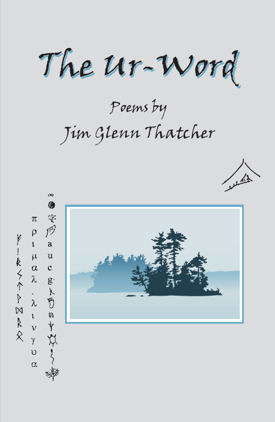
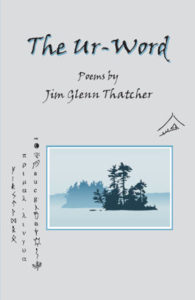 The Ur-Word,
The Ur-Word,
by Jim Glenn Thatcher,
Moon Pie Press, 2008,
33 pages, paper, $9.00, ISBN: 978-1-60643-189-4
Jim Thatcher recites his poems with a mesmerizing, cantorial tenor voice. I have witnessed the arc of his art over two decades: as friend, teaching colleague, and member of the same writing workshop. A reading of his Moon Pie Press chapbook, The Ur –Word, assures me that his “voice” has heightened in poetic pitch — like an instrument fine-tuned, its timbre is idiosyncratic — in the best possible sense.
For Thatcher is, to use jazz lingo, “a deep cat.” From the author’s notes: “He has never lost his deep interest in literature, philosophy, and the idea(s) of history, both natural and human.” This is a fair assessment, but readers will also mine valuable nuggets of astronomy, astrology and mythology. Hence, the The Ur–Word (the first or original word) explores the origins of these histories — and of language itself — as applied to Thatcher’s own consciousness.
He sets out to capture what he calls “the endless epiphany of existence” (“Interlinear,” page 4), and succeeds admiringly. Safe to say, Jim’s is a “poetry of ideas”: reflecting not his ego but an enormous trove of learning. While it might be tempting — given this capacity — to veer into abstraction, Thatcher nicely pairs off his concepts with concrete, sensual details. Take the following passage from “Ice Night.”
Time itself seemed frozen into Presence —
An energy congealed, and taut with brittle tension.
No wind blew and no thing moved,
And only sound seemed living:
Old pines cracked like pistols in the woods, and
On the lakes the pressure of the ice reached crystal mass
To split against itself
In lightning fissures cracking out . . . (20)
Thatcher also reveals a savvy balance when it comes to sentence structure. There are many short, pithy fragments. These add “punch,” playing against longer sentences ably broken up with commas, semicolons, and colons.
Such long phrases dominate the ambitious title poem (two-and-a-half pages in length). Someone of a more limited imagination might have “channeled” the Gospel of John (“In the beginning was the Word . . . . ); but Thatcher begins by predating Genesis!
Before the beginning there was No Thing; not time, nor light, nor space:
A formlessness without measure; neither great nor small, nor finite
nor infinite, and from that no-thing formed one atom, the egg of
existence: matter imagining itself into being, and within that atom
curled the Ur-Word . . . . (23)
Here, and in the phrases to come, Thatcher is at his most lyrical with the repetitive devices of rhetoric. But he doesn’t lapse into rhetorical cant. It’s an hypnotic poem, deserving to be the centerpiece of this chapbook.
The overall structure of The Ur–Word — the book — is well-paced, preparing us for this grand, sometimes allusive poem. The book sagely starts at its most accessible; but towards the end there are three poems with footnotes — leading readers into a rarified “trifecta” — that of a Greek philosopher of mathematics, later a back-to-back pair of poems addressing two ancient Asians. (This reader would have appreciated more footnotes elsewhere, as well.) However, The Ur–Word, even if sometimes a challenging “read,” more than rewards any effort required to do so — with its depth of material, by the poet’s generosity — in sharing his erudition in such musically-phrased language.
This book review would be remiss not to mention the wry comedy imbedded throughout this work. “Sanding Blue Doors” (6-7) is “an outright hoot” in its comparing the sanding of blue paint as creating clouds and constellations in the poet’s mind. I also enjoyed the beginning of “Different Waters Flowing” (15). “The third person: He realizes again / how he likes to think of himself this way, / knowing it’s a ruse. Closing the I and opening the eye.” Yet, appropriately enough, Thatcher saves his best comic lines for the title poem itself: “Ur delights in the jealous arrogance of the poet, who sings Ur’s / praises as though Ur was for poets alone. Ur gets the joke, and it / isn’t on Ur.” Man, am I jealous of that line!
Get your hands on a copy of this handsome, glossy-gray-colored book. On it is centered a Zen-like photograph of pine trees in silhouette; to the left are characters — and symbols — from ancient alphabets denoting, in essence “first word.” A fitting “preface” for fine work.
— Peter Manuel


